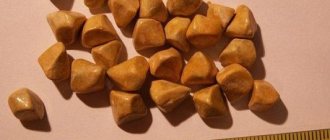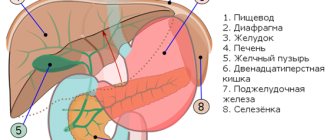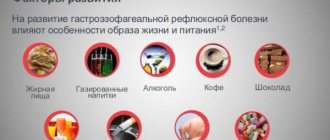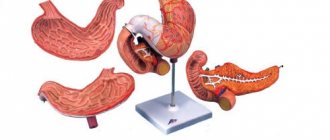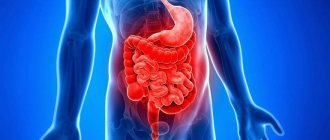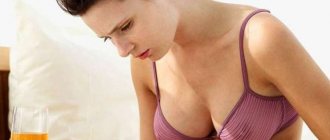Due to blockage of the gallbladder and/or ducts, a violation of the outflow of bile occurs. This condition causes an attack of cholelithiasis .
Every 10th man and every 5th woman is affected by this disease. More than half of people with gallstones may not experience symptoms. In the first 10 years after the discovery of stones, the risk of colic is 2-3%, then it decreases.
What types of cholelithiasis are there? Formulation and symptoms of different types of disease
There are four forms of gallstone disease:
- Latent;
- Dyspeptic;
- Painful;
- and recurrent.
Latent cholelithiasis does not manifest itself with symptoms for a long time, and there are also cases where stones were detected through ultrasound examinations for other complaints.
The dyspeptic form is different:
- heaviness in the right side after eating;
- frequent heartburn;
- constant flatulence;
- unformed chair.
Pain in this form of gallstone disease occurs after eating fatty, fried or spicy foods, overeating, or prolonged refusal of food.
The painful form, contrary to its name, does not have acute, severe pain in symptoms, however, it is characterized by:
- tolerable, aching pain under the ribs on the right, radiating to the shoulder blade and lasting quite a long time;
- weakness, malaise;
- irritability, tearfulness.
This form is referred to as the chronic stage of the disease.
Symptoms of the recurrent form include:
- a sudden attack of severe pain in the area of the right hypochondrium and scapula;
- nausea;
- digestive disorders.
Similar symptoms appear after eating fatty foods, spices, severe stress, and physical activity. And also in women, pregnancy or menstruation can provoke pain.
Diagnostics
Based on the results of the initial examination, biliary colic is identified by acute pain and a number of other symptoms.
The main stage of diagnosis is to determine the root cause of the pathological condition. For these purposes, a number of techniques are used, which are selected depending on the condition and age of the patient. General list of diagnostic procedures:
- standard ultrasound of the gallbladder, liver, pancreas - to identify constrictions, narrowings, stones in the ducts, assess the condition of the bile duct system;
- Ultrasound with a choleretic breakfast - to assess the functional capacity and contractility of the organ (if dyskinesia is suspected);
- duodenal intubation - for quantitative and qualitative analysis of bile;
- cholecystography - to assess the condition of the affected organ using X-rays and contrast injected directly into the ducts;
- cholangiography with intravenous contrast;
- gastroduodenoscopy - for visual examination of the inner surface of the stomach and duodenum.
To make an accurate diagnosis, it is necessary to undergo laboratory tests. When visiting a doctor, the patient describes his complaints and talks about the presence of concomitant diseases. As a rule, people who are prone to gallstone disease have a characteristic appearance - obesity, lipid deposits on the skin (xanthomas). Patients often complain of bloating, heaviness in the side after eating and general malaise.
https://www.youtube.com/watch?v=eaqUGYz9D6g
Such patients are referred to a gastroenterologist, who will prescribe a general blood and urine test and a biochemical examination. The presence of a disorder of the hepatobiliary system is indicated by increased bilirubin and its content in the urine, liver tests, cholesterol, leukocytes, and ESR. Next, the patient is sent for an ultrasound of the abdominal organs, where advanced cholelithiasis is detected, which can cause biliary colic and blockage of the ducts.
ICD code
In the ICD-10 list, cholelithiasis is encrypted under code K80 - Cholelithiasis (cholelithiasis).
K80.0 should be understood as acute cholecystitis with stones, and K80.1 should be understood as the same chronic disease.
K80.2 is a code for gallstones that do not have signs of cholelithiasis or cholecystitis, and K80.3 is used if it is necessary to code a diagnosis with symptoms of cholangitis.
Drugs
Since the root cause of the problems is a spasm of the muscular wall of the bladder, treatment of biliary colic with medications should begin with antispasmodics, such as Drotaverine, No-shpa, Platifilin, Papaverine. Additionally, you need to take painkillers and non-steroidal anti-inflammatory drugs, such as Metamizole, Ketorolac.
Approximate injection patterns:
- 1 ml of 0.1% solution of “Atropine” with 1 ml of “Promedol”;
- 5 ml "Baralgina" with 2 ml "No-shpa".
Injections must be given intramuscularly. This will speed up the effect of the drugs. When biliary colic does not subside for several hours, the condition turns into acute cholecystitis. This requires a different treatment principle and other medications. The type of drugs and treatment algorithm are selected by the doctor.
How to understand that an attack of cholelithiasis has begun?
The attack occurs due to the movement of stones from the gallbladder into the ducts. If the stone is too large, it clogs the duct, and the person feels severe, sharp, unbearable pain under the right ribs.
Most often the attack occurs at night. Pain from the hypochondrium gradually spreads to the right shoulder blade, shoulder, neck, upper abdomen and steadily increases. The pain is accompanied by nausea; with the onset of vomiting, the attack subsides slightly. The abdomen is swollen throughout the attack; it is almost impossible to palpate its right side.
Factors provoking the development of an attack
An attack of cholelithiasis occurs due to the migration of gallstones, resulting in blockage of the bile ducts. This movement of stones begins with increased production and outflow of bile, as well as with spasm of the gallbladder or its ducts. There are a number of factors that can provoke this:
- sudden body movement, physical activity;
- stress;
- spicy or fatty foods or poor diet for gallstone disease;
- excessive fluid intake;
- long stay of the body in an inclined position.
Even pregnancy can cause an attack. When carrying a child, mechanical compression of the bile ducts occurs and, as a result, stagnation of bile. In the last month of pregnancy, cholesterol levels rise, which can also lead to the formation of stones.
What triggers an attack of gallstone disease?
An attack may well be triggered by the following factors:
- alcoholism or even drinking alcohol within reasonable limits;
- irregular diet, frequent feeling of hunger;
- the predominance of fatty, fried, hot, spicy, canned foods or fast food in the diet;
- frequent overeating;
- sedentary work, lack of sufficient physical activity;
- obesity;
- pancreatitis;
- use of hormonal pills;
- pregnancy;
- gallbladder dyskinesia.
How to relieve an attack of cholelithiasis?
You can reduce pain by:
- rest (put the patient to bed and once again try not to disturb him);
- a warm bath or heating pad, which should be applied to the right hypochondrium;
- antispasmodic (No-Shpa, Papaverine, Platifilin, Eufillin);
- as well as calling an ambulance.
Before the doctor arrives, if the patient has chills, you can cover him with a blanket and warm his feet with heating pads, as well as give him warm water. Naturally, there should be no food during such a period. The patient should not be left alone, as he may vomit or faint.
It is more than necessary to call a doctor, because the situation may require surgical treatment, refusal of which will lead to disastrous consequences.
Urgent Care
Emergency first aid includes the following steps:
- Freeing the patient from constricting, tight clothing.
- Ensuring complete rest by adopting a lying position on the right side.
- In case of colic caused by the passage of a stone, an anesthetic drug - Atropine or Promedol - should be administered.
- The spasm is relieved by the administration of Eufillin. Antispasmodic tablets will not work if you are vomiting.
- If it is definitely established that the cause of the pain is biliary colic, it is permissible to apply a warm heating pad to the sore spot.
- If the pain is caused by an attack of cholecystitis, cold is applied to the right side. The procedure will prevent the development of peritonitis.
If the algorithm is ineffective, urgent hospitalization of the patient is required.
Disease prevention
The main prevention of gallstone disease is proper nutrition. It is important to exclude from the diet:
- fatty, fried foods, grilled or with large amounts of oil;
- concentrated broths;
- fat meat;
- hot sauces in dishes and fiery seasonings;
- fast food, fast food, snacks;
- pickles, canned foods.
Eating food that does not provoke the formation of gallstones occurs 5-6 times a day. The portions, however, are not large; after eating you should still feel full.
It is important to lead an active lifestyle, not to succumb to stress, not to self-medicate, and to take vitamin and mineral complexes only after consulting a doctor.
What should you do to avoid seizures?
To prevent attacks of cholelithiasis from bothering you, you must:
- consult a doctor in a timely manner for treatment, as soon as the pain first appears, you must call a doctor and follow all his prescriptions;
- do not self-medicate;
- eat foods allowed in the diet for cholelithiasis;
- adhere to moderate physical activity, avoid active, active sports (aerobics, step, running) and strength exercises (lifting weights in any position);
- give up gardening, because staying in a bent position for a long time can provoke an attack;
- try to avoid shaking in transport;
- do not be nervous;
- do not smoke or drink alcohol.
How is gallstone disease treated?
Treatment of gallstone disease requires strict adherence to medical prescriptions. It can be medicinal, physiotherapeutic, surgical or sanatorium-resort, depending on the form of the disease and its degree.
For example, if there is only one stone, but it is large, or many stones have formed, the doctor will most likely decide to remove the gallbladder.
When there is only one stone and its size does not exceed 1 cm or there are many small formations, the doctor may advise resorting to dissolving or crushing them. The dissolution method is especially relevant for cholesterol stones. However, after crushing or dissolving, in half of the cases the disease returns again.
Any treatment must be accompanied by a change in the diet and nature of the diet, since often an incorrect diet is the main reason for the formation of stones.
Sanatorium-resort treatment of cholelithiasis consists of the following points:
- moderate physical activity - patients are prescribed a physical activity regimen, namely therapeutic walking without sudden movements and fast paces;
- treatment with mineral waters using waters of medium and low mineralization;
- nitrogen and oxygen baths, in which the patient remains for no more than 15 minutes at a temperature of 35 to 37 ° C.
Also, in the conditions of a sanatorium, both the climate itself and the dietary nutrition of the institution have a positive effect on the patient.
Therapeutic exercise for cholelithiasis
If it is not possible to go to a sanatorium for treatment, then while at home you can create optimal conditions for normal bile flow, for example, by performing special exercises as a supplement to basic medical instructions.
A person diagnosed with gallstones should not jump rope, hula hoop, do abs, or engage in athletics. In this case, the loads should be moderate, without sudden changes in postures and movements. Regular walks in the fresh air at a measured pace or swimming are good options. You can also do special gymnastics every day, slowly:
- Sitting on a chair, keep your legs straight and place your palms on your knees. As you inhale, spread your legs and arms to the sides, and as you exhale, return to the starting position.
- Without changing position, raise your arms up through the sides while inhaling upward, and exhaling return your palms to your knees.
- Straighten your legs, keeping your feet shoulder-width apart. Lean forward with springy movements.
- Without changing the starting position, raise your legs, bending your knees, and place your feet on the chair.
- Rest for 30 seconds and lie down on the floor.
- Lying on the floor, bend your knees as you inhale and straighten them out, sliding along the floor.
- Bend your knees and tilt them as you inhale, holding them together, right and left, stopping at the exit in the center.
- Lower your feet to the floor and breathe deeply.
- Kneel down and bend your elbows, approach the floor as you inhale, and move away as you exhale.
- Without changing position, arch your back as you inhale, bend as you exhale.
- Get to your feet and walk in place at a moderate pace for 3 minutes.
- Stop and raise your arms up as you inhale, lower them to chest level as you exhale. Repeat 4 times and the gymnastics can be considered complete.
Treatment in hospital
In the absence of indications for emergency surgery, the doctor prescribes conservative treatment, which is aimed at stopping the attack and eliminating inflammatory processes in the gallbladder and its ducts:
- subcutaneous administration of antispasmodics (Papaverine, Baralgin, Platiphylline or No-shpa);
- antibiotics;
- if antispasmodics do not help, it is necessary to perform a blockade of the round ligament of the liver or a perinephric blockade with novocaine.
Usually such measures are quite enough to relieve an attack. If after two days the patient’s condition does not return to normal, emergency surgery is necessary due to the high risk of complications - biliary peritonitis or destructive (gangrenous or perforative) cholecystitis.
